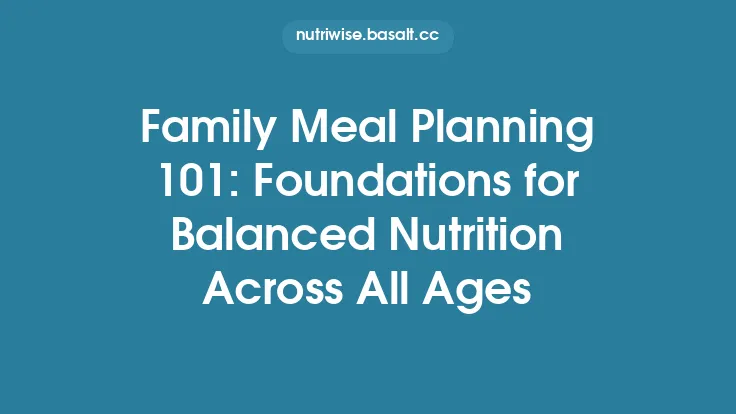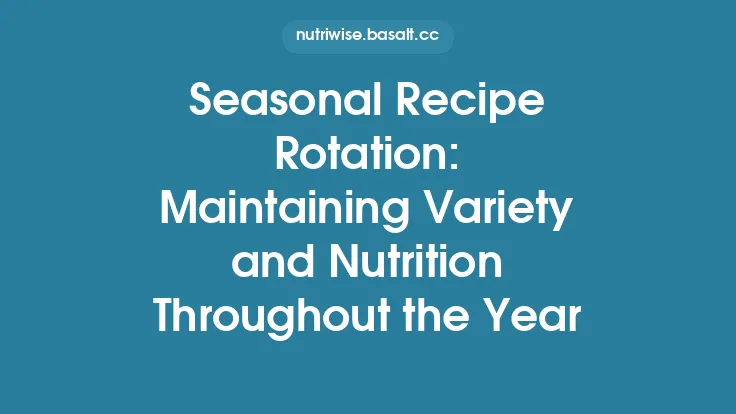Seasonal meal planning is more than a calendar‑based grocery list; it is a holistic approach that weaves together nutrition science, cultural heritage, and practical household management. By aligning menus with the natural rhythm of the year, families can enjoy foods at their peak flavor and nutritional value while honoring the culinary customs that define their community. This article explores the evergreen strategies for constructing balanced, culturally resonant menus throughout the twelve months, offering a framework that can be adapted to any locale or tradition.
Understanding Seasonal Food Cycles in Cultural Contexts
Every culture has evolved a set of food practices that correspond to the changing environment. Historically, these practices emerged from necessity—what could be harvested, stored, or foraged at a given time—and gradually became embedded in rituals, celebrations, and daily meals. Recognizing these cycles involves two complementary lenses:
- Ecological Lens – Identifies the natural availability of macronutrient‑rich staples (grains, tubers, legumes) and micronutrient‑dense produce (leafy greens, root vegetables, fruits) across the year.
- Cultural Lens – Maps traditional dishes, preparation methods, and festive foods onto the ecological timeline, revealing why certain meals are associated with specific months or holidays.
By charting both lenses side by side, planners can see where cultural expectations intersect with nutritional opportunities, allowing them to preserve tradition while optimizing health outcomes.
Core Principles of Balanced Meal Planning Across Seasons
- Macro‑Balance – Aim for each main meal to contain a source of complex carbohydrates, high‑quality protein, and healthy fats. Seasonal variations may shift the dominant carbohydrate (e.g., rice in the monsoon season, barley in the dry months) but the principle remains constant.
- Micro‑Diversity – Ensure a spectrum of vitamins and minerals by rotating color groups (deep‑red, orange, green, purple) weekly. Seasonal produce naturally provides this diversity; the planner’s job is to guarantee representation across meals.
- Portion Timing – Align heavier, carbohydrate‑rich meals with periods of higher physical activity (often coinciding with agricultural labor seasons) and lighter meals during lower‑activity periods.
- Cultural Continuity – Preserve signature dishes that hold symbolic meaning, but consider ingredient swaps that maintain flavor profiles while enhancing nutritional balance (e.g., using lentil‑based dough instead of refined flour for a traditional flatbread).
Integrating Cultural Traditions into Seasonal Menus
Cultural food traditions are the emotional backbone of any meal plan. To integrate them without compromising balance:
- Identify Anchor Dishes – Pinpoint the few dishes that are non‑negotiable for festivals or family gatherings.
- Deconstruct Nutritional Profile – Break down each anchor dish into its macro and micronutrient components.
- Strategic Augmentation – Add side dishes or condiments that fill any nutritional gaps. For instance, a traditional winter stew rich in protein but low in vitamin C can be paired with a fermented vegetable relish that supplies the missing micronutrient.
- Seasonal Substitutions – Replace out‑of‑season ingredients with locally available analogues that mimic texture and flavor. A classic summer salad featuring cucumber can be re‑imagined with crisp radish or jicama during the cooler months, preserving the dish’s cultural identity while respecting seasonality.
Macro‑ and Micronutrient Balancing Throughout the Year
| Season | Typical Carbohydrate Base | Primary Protein Sources | Key Micronutrient Focus |
|---|---|---|---|
| Spring | Whole‑grain millets, young barley | Freshwater fish, eggs | Folate, Vitamin C (from early greens) |
| Summer | Rice, sorghum | Legumes, poultry | Potassium, Magnesium (from leafy and fruit crops) |
| Autumn | Root‑starch tubers, oats | Game meat, dairy | Vitamin A, Iron (from squashes and dark greens) |
| Winter | Fermented grains, preserved legumes | Cured meats, nuts | Vitamin D (via fortified foods), Selenium (from nuts/seeds) |
These categories are not prescriptive; they serve as a scaffold. Within each season, the planner should aim for a 40‑30‑30 distribution (carbs‑protein‑fat) as a starting point, adjusting based on individual energy needs, activity levels, and cultural expectations.
Strategic Shopping and Storage for Seasonal Menus
- Market Timing – Visit local markets early in the day when vendors display the freshest harvest. Establish relationships with farmers to gain insight into upcoming yields.
- Batch Procurement – Purchase staple items (grains, legumes) in bulk during off‑peak months when prices are lower, then store them in airtight containers to maintain freshness.
- Preservation Techniques – While deep winter preservation methods belong to a neighboring article, basic techniques such as refrigeration, controlled‑temperature root cellars, and simple dehydration can be employed year‑round to extend the usability of seasonal produce without altering its nutritional profile.
- Inventory Audits – Conduct a weekly audit of pantry and fridge contents, cross‑referencing with the upcoming week’s menu to minimize waste and ensure that perishable items are used at their nutritional peak.
Menu Design Templates for Each Season
Spring Template
- Breakfast: Fermented millet porridge with fresh herb garnish and a boiled egg.
- Lunch: Light fish broth with early greens, quinoa, and a drizzle of sesame oil.
- Snack: Yogurt with a spoonful of locally sourced honey and a handful of sprouted beans.
- Dinner: Stir‑fried tofu with asparagus‑like shoots, served over barley pilaf.
Summer Template
- Breakfast: Cold sorghum salad with diced mango, lime, and toasted pumpkin seeds.
- Lunch: Grilled chicken kebabs with a side of chilled cucumber‑mint salad and whole‑grain flatbread.
- Snack: Fresh fruit smoothie fortified with whey protein and a pinch of sea salt.
- Dinner: Legume‑based stew with summer squash, tomatoes, and a side of fermented rice.
Autumn Template
- Breakfast: Oatmeal enriched with roasted chestnuts, cinnamon, and a dollop of kefir.
- Lunch: Braised rabbit with root vegetables, served over a bed of wild rice.
- Snack: Roasted pumpkin seeds seasoned with smoked paprika.
- Dinner: Hearty lentil soup with kale, accompanied by a whole‑grain flatbread brushed with olive oil.
Winter Template
- Breakfast: Warm barley porridge with dried figs, a splash of fortified plant milk, and a sprinkle of ground flaxseed.
- Lunch: Slow‑cooked stew of preserved beans, cured pork, and winter greens, served with fermented rye bread.
- Snack: Nut butter on toasted whole‑grain crackers, paired with a cup of herbal tea.
- Dinner: Baked fish with a crust of crushed nuts, served alongside sautéed cabbage and a side of pickled vegetables.
These templates illustrate how a balanced macro‑micronutrient profile can be achieved while staying true to cultural flavor palettes.
Adapting Recipes to Seasonal Variations
When a beloved recipe calls for an ingredient that is out of season, follow a systematic adaptation process:
- Identify Functional Role – Is the ingredient providing texture, moisture, acidity, or a specific nutrient?
- Select Seasonal Counterpart – Choose a locally available food that fulfills the same functional role. For example, replace summer tomatoes in a sauce with roasted beet puree for color and natural sweetness during winter.
- Adjust Cooking Parameters – Seasonal produce may have different water content or fiber structure; modify simmer times or liquid ratios accordingly.
- Taste Test and Refine – Conduct a brief sensory evaluation, noting any shifts in flavor balance, and adjust seasoning or aromatics to restore the intended profile.
By treating recipes as modular systems rather than static scripts, cooks can maintain cultural continuity while respecting seasonal availability.
Cultural Festivities and Their Impact on Meal Structure
Festive periods often dictate deviations from everyday macro balance—rich, indulgent dishes become central. To mitigate potential nutritional imbalances:
- Pre‑Festivity Planning – Increase intake of fiber‑rich foods and hydration in the days leading up to celebrations to support digestion.
- Portion Management – Serve traditional dishes in smaller, family‑style bowls, encouraging sampling rather than overconsumption.
- Complementary Sides – Pair heavy main courses with light, vegetable‑forward sides that provide contrast and micronutrient density.
- Post‑Festivity Reset – Schedule a “recovery week” featuring broth‑based meals, fermented foods, and increased water intake to restore gut health and metabolic balance.
These strategies honor the cultural significance of feasts while safeguarding long‑term health.
Practical Tools and Resources for Ongoing Seasonal Planning
- Digital Calendars with Food‑Seasonality Overlays – Apps that integrate local harvest calendars allow users to visualize peak produce weeks at a glance.
- Nutrient‑Tracking Software – Programs that calculate macro‑micronutrient distribution per meal help ensure each menu meets the 40‑30‑30 guideline.
- Community Recipe Exchanges – Online forums or local co‑ops where members share adapted traditional recipes foster cultural continuity and innovation.
- Seasonal Shopping Lists Templates – Printable checklists organized by food groups and storage methods streamline market trips and reduce impulse purchases.
Investing time in these tools pays dividends in consistency, reduced food waste, and sustained cultural engagement.
Conclusion: Sustaining Healthful Traditions Year‑Round
Seasonal meal planning sits at the intersection of nutrition science, cultural heritage, and practical household management. By grounding menus in the natural ebb and flow of food availability, respecting the symbolic weight of traditional dishes, and applying systematic balancing techniques, families can enjoy flavorful, nutritionally complete meals throughout the year. The evergreen framework presented here—understanding cycles, applying core balancing principles, integrating cultural anchors, and leveraging modern planning tools—offers a resilient blueprint that can adapt to changing climates, evolving tastes, and diverse cultural landscapes. Embracing this approach not only nourishes the body but also reinforces the communal bonds that are woven through shared meals, ensuring that the wisdom of the past continues to feed the health of future generations.





